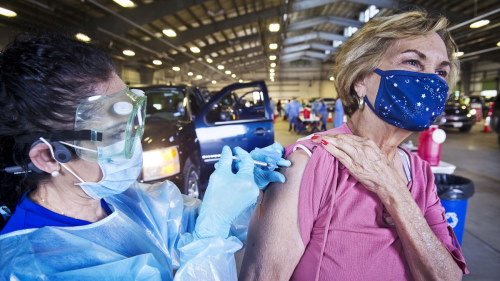- According to the Centers for Disease Control and Prevention (CDC), more than 96.4 million doses of vaccine against the virus have been delivered to healthcare centers across the country.
- Experts have estimated that 70 to 90 percent of people may need to be immune against the virus to achieve herd immunity.
- How fast we get to that point will depend on how quickly vaccines are manufactured, delivered, and administered.
BREAKING: Doctors Can't Believe She Used This To Erase Her Wrinkles...
After a rocky start, COVID-19 vaccination campaigns have been picking up pace in many communities across the United States.
According to the Centers for Disease Control and Prevention (CDC), more than 96.4 million doses of vaccine against the virus have been delivered to healthcare centers across the country.
About 76.9 million have been administered.
An estimated 15 percent of people in the country have received at least one dose of vaccine. About 7.7 percent have gotten two doses.
Experts have recently estimated that 70 to 90 percent of people may need to be immune against the virus to achieve herd immunity.
When enough Americans have immunity against the virus to stop it from spreading within the population, that’s known as herd immunity.
How fast we get to that point will depend on a number of factors, including how quickly vaccines are manufactured, delivered, and administered.
Three authorized vaccines
The Food and Drug Administration (FDA) has so far issued Emergency Use Authorizations for three COVID-19 vaccines.
In December, the FDA approved the use of the Pfizer-BioN vaccine in people age 16 and older and the use of the Moderna vaccine in people age 18 and older. Both vaccines require two doses, given several weeks apart.
On Saturday, the FDA approved the use of a third vaccine produced by the Johnson & Johnson subsidiary Janssen Biotech. It requires only one dose.
Research suggests that the Pfizer-BioNTech and Moderna vaccines are more than 90 percent effective at preventing COVID-19.
The Johnson & Johnson vaccine is more than 65 percent effective at preventing moderate to severe cases of the disease.
Timeline to immunity
March: 220 million doses
In a congressional hearing on February 23, officials from Pfizer and Moderna told lawmakers that their companies are on track to deliver 120 million and 100 million doses respectively by the end of March. This includes doses already given out.
This would mean 110 million Americans could potentially be fully vaccinated from these doses.
June: Another 100 million doses
Johnson & Johnson has also pledged to provide up to 100 million doses of its single-shot vaccine by the end of June.
Since this is a single dose vaccine, another 100 million people could be fully vaccinated from these doses.
July: Over 700 million doses
If these manufacturers hit their delivery targets, there will be more than enough vaccine in the United States to vaccinate every adult in the country by the summer.
In total, Pfizer and Moderna have each pledged to provide 300 million doses of vaccine to the United States by the end of July, or 600 million total — this includes the 220 million doses pledged by the end of March.
With 600 million doses, that’s enough to vaccinate 300 million people.
The additional 100 million doses from Johnson & Johnson would mean there’s more than enough to vaccinate the over 330 million U.S. citizens.
Getting doses to Americans
But getting the vaccine from manufacturers to the federal government is only one step of the process.
From there, the federal government delivers weekly allocations of the vaccine to state and territorial authorities, which dispatch it to local health departments, hospitals, and pharmacies.
The CDC has designated three groups as the ones that should get the vaccine first:
Phase 1a
- healthcare personnel and long-term care facility residents (these vaccinations started in mid-December)
Phase 1b
- frontline and essential workers including firefighters, postal workers, and food and agricultural workers
- people over age 75
Phase 1c
- people ages 65–74
- people between the ages of 16–64 with underlying health conditions that put them at high risk for COVID-19
- other essential workers, including people in food service, public health, transportation, and construction
Some states have been more efficient than others at getting the vaccine out to the public, said Elaine Kamarck, PhD, director of the Center for Effective Public Management at the Brookings Institution in Washington, D.C.
“Every state is getting an allocation of vaccines in proportion to their population,” Kamarck said, “but some states seem to be much better at getting the vaccine into people’s arms.”
For example, New Mexico has administered roughly 95 percent of the doses delivered by the federal government to the state. About 22 percent of its population has gotten at least one dose so far.
In comparison, nearby Kansas has administered 70 percent of the doses delivered by the federal government to the state. Nearly 15 percent of its population has gotten at least one dose.
Persistent disparities
According to Kamarck, the gap in vaccination rates between states has been closing since she wrote about this issue for Brookings last month.
However, racial disparities in vaccine uptake have emerged within and across states, said Andrea Carcelen, an assistant scientist at the International Vaccine Access Center at the Johns Hopkins Bloomberg School of Public Health in Baltimore, Maryland.
Black Americans are more likely than white Americans to not only develop but also die from COVID-19. However, Black Americans are less likely to have been vaccinated against the virus.
Citing data from the Kaiser Family Foundation, Carcelen said that in Maryland, Black people represent 33 percent of the [COVID-19] cases and 35 percent of the deaths, “but only 16 percent of those who are getting vaccinated.”
“That pattern is kind of consistent across states,” she continued, “so we’re seeing this disparity across the rollout.”
Looking forward
As the production and supply of vaccines grow, public health authorities and their private partners will need to continue to improve their distribution systems and methods.
Some communities have set up mass vaccination sites, like those established at Gillette Stadium, Fenway Park, and the Reggie Lewis Center in Boston, Massachusetts.
Some have started to distribute the vaccine through retail pharmacies and community health centers, as well as hospitals.
Kamarck hopes the authorization of the Johnson & Johnson vaccine will not only bolster the overall supply of vaccines, but also enable distribution.
While the Moderna vaccine needs to be stored at ultra-low temperatures, the Johnson & Johnson vaccine only needs to be refrigerated. And now the FDA has said the Pfizer vaccine can be stored in a standard freezer.
This will make it easier to distribute vaccines at sites without specialized freezers.
“The Johnson & Johnson vaccine could be a game changer,” Kamarck said. “With the ease of storage, maybe they can expand to both local pharmacies and to primary care physicians.”
TRENDING: This Keeps Your Blood Sugar Below 100 - Even When You're Eating Sweets!
To help underserved community members learn about and access the vaccine, Carcelen said that collaboration between health authorities and local community organizations is also important.
“[Something] that I’d like to see more of is garnering trust and tailoring messages with community organizations,” she said, “whether that’s civil society or faith-based organizations.”









